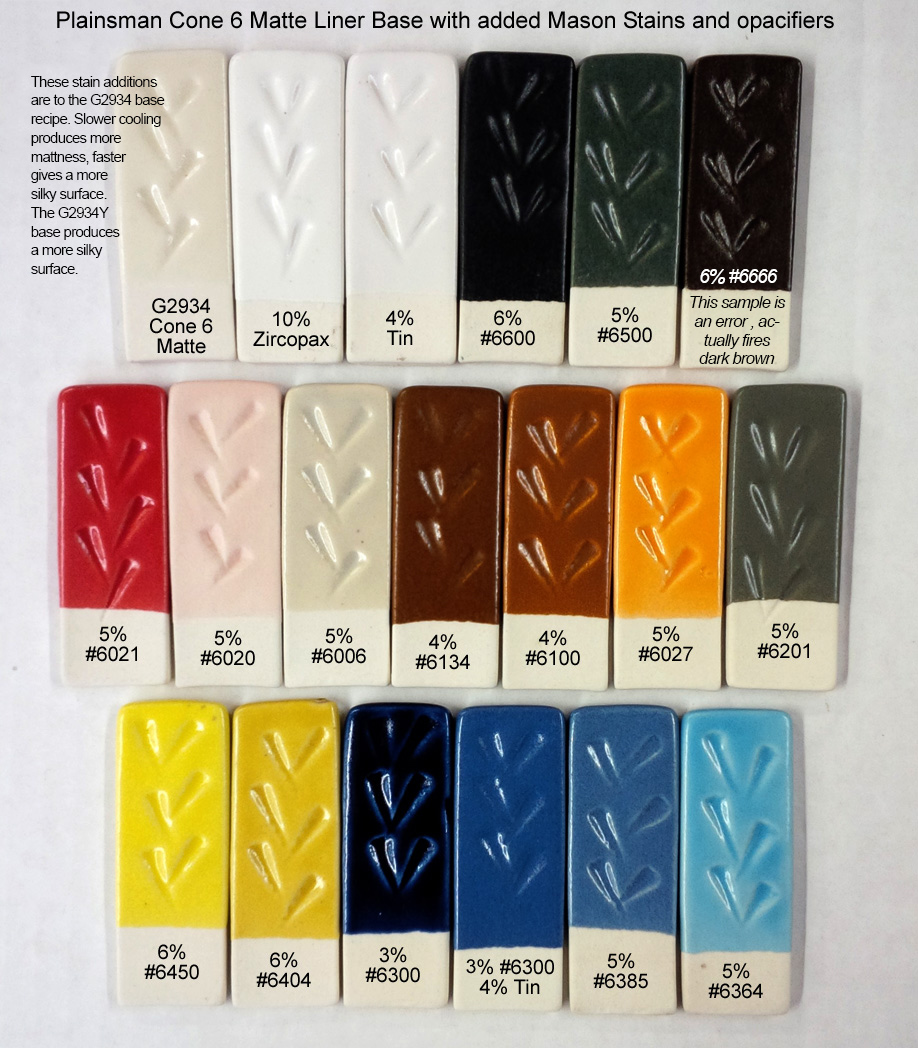| Monthly Tech-Tip | No tracking! No ads! |
G2934 cone 6 DIY MgO matte glaze: Reliable, durable, adjustable, stainable
These pieces were made from Plainsman Polar Ice and fired to cone 6 using variations on the PLC6DS and C6DHSC schedules. The dipping glaze is G2934Y, a recipe variant of G2934 having a finer micro-surface texture (it has the same chemistry but the MgO is sourced from a frit and talc instead of dolomite). These mugs display how well the recipe works with stains and the varying degrees of matteness we can achieve by varying the cooling rate and the percentage of glossy G2926B base blended in. As an MgO matte, this glaze can have a surface pleasant to the touch. It fires durable, can be quite matte without cutlery marking and it has very good slurry and application properties (as a dipping glaze). It has a very low thermal expansion (won’t craze). It works really well with stains (except purples). It melts even better than the glossy!
Related Pictures
Souvenir mugs that demonstrate incredible workmanship, glaze recipes, use of decals

This picture has its own page with more detail, click here to see it.
These porcelain mugs are sold at many tourist shops on the Alaskan cruize circuit. Made in China of course. But their quality is astounding. And they teach multiple lessons to potters - great skill in the use of decals (even inside), meeting different glazes at the rims, evenness of application, layering, the use of wax resist, etc. They likely have a glossy and matte base glaze and add stains (to get the black, blue, red, white, green). Notice they have an iron red (lower right) that is stable enough not to run and host an even more fluid melt second layer. They also have a stoney yet functional matte white (bottom left). And they are using encapsulated stains to get that bright red (even on food surfaces). You can make dipping glaze versions of all of these:
Black glossy: G3914A and G2926BL
Black matte: G2934BL
Iron Red: G3948A
White stoney matte: G2934Y2
Glossy colors: Add stains to G2926B
Matte colors: Add stains to G2934
G2926B cone 6 transparent liner glaze: Proven, reliable, durable

This picture has its own page with more detail, click here to see it.
While colorful and layered glazes on the outsides of pieces get lots of praise and glory, transparent or white glazes providing the functional surface on the insides of pieces often get little attention from potters. Really, what good is an attractive piece if the food surface is crazing, blistering, leaching or cutlery marking? Or if it converts the piece into a time bomb? This cone 6 liner glaze, G2926B, is an example of how I found a glaze, recognized its potential and then adjusted the recipe to resist crazing on our clay bodies, fire durable and leach resistant and act as a base to host colorants, opacifiers and variegators. I get the best fired results using the C6DHSC firing schedule and very good performance as a dipping glaze when the slurry is thixotropic. One of the reasons this recipe is so widely used is that it is well-documented, having a code number that Google indexes. Drinking from a mug having a quality and fitted functional surface and a nice crisp line dividing the outside and inside glazes instills pride in me as the maker. What is the outside glaze? It is the G2934Y matte base recipe plus 8% Mason 6027 stain. The clay is MNP which I make myself.
Mason stains in the G2934 matte base glaze at cone 6

This picture has its own page with more detail, click here to see it.
Stains can work surprisingly well in matte base glazes like the DIY G2934 recipe. The glass is less transparent and so varying thicknesses do not produce as much variation in tint as glossy bases do. Notice how low many of the stain percentages are here, yet most of the colors are bright. We tested 6600, 6350, 6300, 6021 and 6404 overnight in lemon juice, they all passed leach-free. The 6385 is an error, it should be purple (that being said, do not use it, it is ugly in this base). And chrome-tin pink and maroon stains do not develop the color (e.g. 6006). But our G1214Z1 CaO-matte comes to the rescue, it both works better with some stains and has a more crystal matte surface. The degree-of-matteness of both can be tuned by cooling speed and blending in some G2926B glossy base. You can mix any of these into brushing or dipping glazes.
Videos
Links
| Recipes |
G1214Z1 - Cone 6 Silky CaO matte base glaze
This glaze was born as a demonstration of how to use chemistry to convert a glossy cone 6 glaze into a matte. |
| Recipes |
G2934 - Matte Glaze Base for Cone 6
A base MgO matte glaze recipe fires to a hard utilitarian surface and has very good working properties. Blend in the glossy if it is too matte. |
| Recipes |
G2934Y - Cone 6 Magnesia Matte Low LOI Version
The same chemistry as the widely used G2934 but the MgO is sourced from a frit and talc instead of dolomite. It has a finer surface, less cutlery marking and staining. |
| Glossary |
Medium Temperature
These are stoneware glazes that fire in the range of 1200C (2200F). They often contain boron to assist with melting. |
Got a Question?
Buy me a coffee and we can talk

https://backup.digitalfire.com, All Rights Reserved
Privacy Policy

